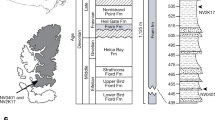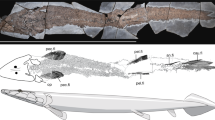Abstract
Studies of the origin1,2,3 and developmental genetics4,5,6,7 of tetrapod limbs have focused attention on the need to identify the precise type of sarcopterygian (lobe-finned fish) fin from which limbs evolved. This can only be achieved through a phylogenetic analysis of sarcopterygians. Sarcopterygian fin skeletons vary in structure8,9; use of an inappropriate fin skeleton as a model limb precursor will lead to erroneous inferences about the evolution of morphology and the developmental pathways at the fish–tetrapod transition. The pectoral fin of the rhizodont sarcopterygian Sauripteris is strikingly limb-like and features prominently in discussions about the origin of limbs3,7,10,11,12,13,14. It is thus important to establish the phylogenetic position of rhizodonts. However, their anatomy is incompletely known15,16. Published phylogenetic analyses are based on poorly substantiated characters, such as the alleged presence of two external nostrils in the Australian genus Barameda17,18. Here we present, from the Upper Devonian period of Canowindra, Australia, the most primitive and by far the most complete rhizodont discovered so far. It has a single external nostril but possesses no other derived tetrapod-like features. Our new evidence shows that rhizodonts are more remote from tetrapods than are osteolepiform18 and elpistostegid19 lobe-fin fishes. Similarities between rhizodont fins and tetrapod limbs are thus probably convergent, and the pectoral fin of Sauripteris should not be used as a model limb precursor.
This is a preview of subscription content, access via your institution
Access options
Subscribe to this journal
Receive 51 print issues and online access
$199.00 per year
only $3.90 per issue
Buy this article
- Purchase on Springer Link
- Instant access to full article PDF
Prices may be subject to local taxes which are calculated during checkout




Similar content being viewed by others
References
Coates, M. I. & Clack, J. A. Polydactyly in the earliest known tetrapod limbs. Nature 347, 66–69 (1990).
Coates, M. I. The Devonian tetrapod Acanthostega gunnari Jarvik: postcranial anatomy, basal tetrapod interrelationships and patterns of skeletal evolution. Trans. R. Soc. Edinb. Earth Sci. 87, 363–421 (1996).
Shubin, N. The evolution of paired fins and the origin of tetrapod limbs. Evol. Biol. 28, 39–85 (1995).
Shubin, N. H. & Alberch, P. Amorphogenetic approach to the origin and basic organization of the tetrapod limb. Evol. Biol. 20, 319–387.
Coates, M. I. in Developmental Patterning of the Vertebrate Limb (eds Hinchliffe, J. R., Hurle, J. M. & Summerbell, D.) 325–337 (Plenum, New York, (1991)).
Sordino, P., van der Hoeven, F. & Duboule, D. Hox gene expression in teleost fins and the origin of vertebrate digits. Nature 375, 678–681 (1995).
Shubin, N., Tabin, C. & Carroll, S. Fossils, genes and the evolution of animal limbs. Nature 388, 639–648 (1997).
Andrews, S. M. & Westoll, T. S. The postcranial skeleton of rhipidistian fishes excluding Eusthenopteron. Trans. R. Soc. Edinb. 68, 391–489 (1970).
Ahlberg, P. E. Paired fin skeletons and relationships of the fossil group Porolepiformes (Osteichthyes: Sarcopterygii). Zool. J. Linn. Soc. 96, 119–166 (1989).
Gregory, W. K. The limbs of Eryops and the origin of paired limbs from fins. Science 33, 508–509 (1911).
Broom, R. On the origin of the cheiropterygium. Bull. Am. Mus. Nat. Hist. 32, 459–464 (1913).
Romer, A. S. The Vertebrate Body (W. B. Saunders, Philadelphia, (1949)).
Schmalhausen, I. I. The Origin of Terrestrial Vertebrates. (Academic, New York, (1968)).
Daeschler, E. & Shubin, N. Fish with fingers? Nature 391, 133 (1998).
Andrews, S. M. Rhizodont crossopterygian fish from the Dinantian of Foulden, Berwickshire, Scotland, with a re-evaluation of this group. Trans. R. Soc. Edinb. Earth Sci. 76, 67–95 (1985).
Cloutier, R. & Ahlberg, P. E. in Interrelationships of Fishes (eds Stiassny, M. L. J., Parenti, L. R. & Johnson, G. D.) 445–479 (Academic, San Diego, (1996)).
Long, J. A. Anew rhizodontiform fish from the Early Carboniferous of Victoria, Australia, with remarks on the phylogenetic position of the group. J. Vert. Palentol. 9, 1–17 (1989).
Ahlberg, P. E. Are-examination of sarcopterygian interrelationships, with special reference to the Porolepiformes. Zool. J. Linn. Soc. 103, 241–287 (1991).
Jarvik, E. Basic Structure and Evolution of VertebratesVol. 1 (Academic, New York, (1980)).
Young, G. C. in Palaeozoic Vertebrate Biostratigraphy and Biogeography (ed. Long, J. A.) 208–251 (Belhaven, London, (1993)).
Vorobyeva, E. I. & Schultze, H.-P. in Origins of the Higher Groups of Tetrapods: Controversy and Consensus (eds Schultze, H.-P. & Trueb, L.) 68–109 (Cornell Univ., Ithaca, NY, (1991)).
Schultze, H.-P. & Arsenault, M. The panderichthyid fish Elpistostege: a close relative of tetrapods? Paleontology 28, 293–309 (1985).
Schultze, H.-P. Dipnoans as sarcopterygians. J. Morphol. 1 (suppl.), 39–74 (1986).
Clack, J. A. Acanthostega gunnari, a Devonian tetrapod from Greenland; the snout, palate and ventral parts of the braincase, with a discussion of their significance. Meddr. Grønland Geoscience 31, 1–24 (1994).
Acknowledgements
We thank the Australian Museum for their award of a Visiting Fellowship to P.E.A. A. Ritchie for inviting us to work on the Canowindra material and J. Long and J. Jeffery for discussions and access to rhizodont material. Z.J. thanks J. Fairfax for financial support. This Letter is dedicated to the memory of S. M. Andrews.
Author information
Authors and Affiliations
Supplementary Information
Rights and permissions
About this article
Cite this article
Johanson, Z., Ahlberg, P. A complete primitive rhizodont from Australia. Nature 394, 569–573 (1998). https://doi.org/10.1038/29058
Received:
Accepted:
Issue Date:
DOI: https://doi.org/10.1038/29058
This article is cited by
-
A Devonian tetrapod-like fish reveals substantial parallelism in stem tetrapod evolution
Nature Ecology & Evolution (2017)
-
Comparative pelvic development of the axolotl (Ambystoma mexicanum) and the Australian lungfish (Neoceratodus forsteri): conservation and innovation across the fish-tetrapod transition
EvoDevo (2013)
-
Cranial morphology of the Silurian sarcopterygian Guiyu oneiros (Gnathostomata: Osteichthyes)
Science China Earth Sciences (2010)
-
The predictability of evolution: glimpses into a post-Darwinian world
Naturwissenschaften (2009)
-
The origin of the internal nostril of tetrapods
Nature (2004)
Comments
By submitting a comment you agree to abide by our Terms and Community Guidelines. If you find something abusive or that does not comply with our terms or guidelines please flag it as inappropriate.



